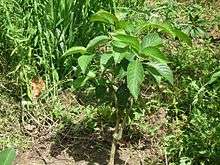Trichanthera
| Trichanthera | |
|---|---|
 | |
| Scientific classification | |
| Kingdom: | Plantae |
| (unranked): | Angiosperms |
| (unranked): | Eudicots |
| (unranked): | Asterids |
| Order: | Lamiales |
| Family: | Acanthaceae |
| Genus: | Trichanthera |
| Species: | T. gigantea |
| Binomial name | |
| Trichanthera gigantea Nees | |
Trichanthera is a monotypic genus[1] of flowering plants in the acanthus family containing the single species Trichanthera gigantea, which is known by many common names, including madre de agua, suiban, cenicero, tuno, naranjillo, and palo de agua. It is native to Central America and northern South America.[2][3] It has also been introduced to other tropical regions such as Vietnam, Cambodia, and the Philippines.[4]
This plant is a shrub or tree growing up to 5 meters tall, though a 15-meter specimen was reported once. It often produces aerial roots. The oval or oblong leaves are up to 26 centimeters long by 14 wide and are borne on short petioles.[4] The flower is maroon with a yellow throat. It is bell-shaped and the throat measures up to 2.5 centimeters long. The plant blooms in the afternoon and the flowers fall away during the night.[2] The flowers are pollinated by bats.[1] The bat Glossophaga soricina has been seen at the flowers of this species.[4]
This plant has many uses for humans. It is cultivated as an animal fodder and fed to ducks,[5] pigs,[5][6] and rabbits.[7] It has veterinary uses in Colombia, where it has been used to treat horse colic and retained placenta in cows. It has uses in human medicine, including as a supplement to increase lactation in nursing mothers. It is used as a living fence and a shade tree.[4]
References
- 1 2 Vogel, S., et al. (2004). Harpochilus neesianus and other novel cases of chiropterophily in neotropical Acanthaceae. Taxon 53(1) 55-60.
- 1 2 McDade, L. A. (1983). Pollination intensity and seed set in Trichanthera gigantea (Acanthaceae). Biotropica 15(2) 122-24.
- ↑ Trichanthera gigantea. tropicalforages.info.
- 1 2 3 4 Rosales, M. (1997). Trichanthera gigantea (Humboldt & Bonpland.) Nees: A review. Livestock Research for Rural Development 9 4.
- 1 2 Nhan, N. T. H. and N. V. Hon. (1999). Supplementing rice by-products with foliage of Trichanthera gigantea in diets of growing and lactating pigs and fattening ducks. Livestock Research for Rural Development 11 3.
- ↑ Jaya, A. F., et al. (2008). Utilization of madre de agua (Trichanthera gigantea var. guianensis) leaf meal as feed for growing-finishing pigs. Philippine J Vet Anim Sci
- ↑ Luyen, L. T., et al (2003). Growing Mulberry and Trichanthera gigantea in association with Flemingia macrophylla on sloping land and using the foliages as feeds for rabbits. In: Proceedings of Final National Seminar-Workshop on Sustainable Livestock Production on Local Feed Resources (Editors: Reg Preston and Brian Ogle). HUAF-SAREC, Hue City, 25 – 28 March, 2003